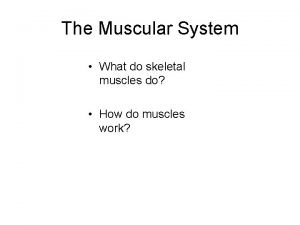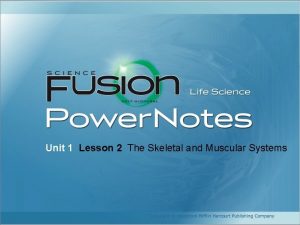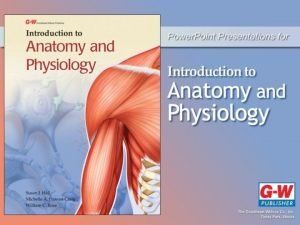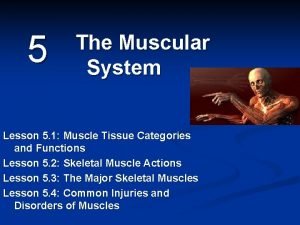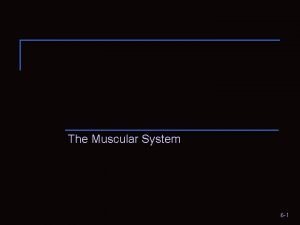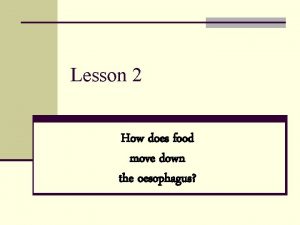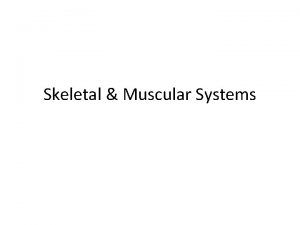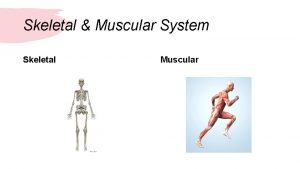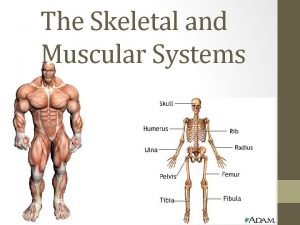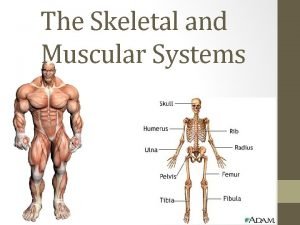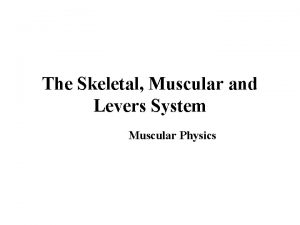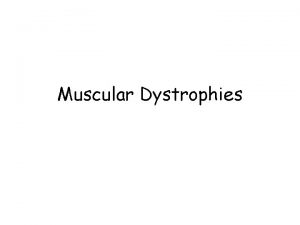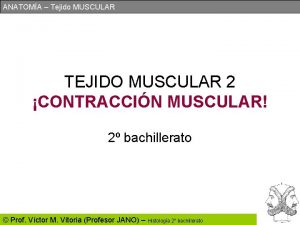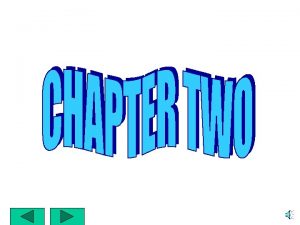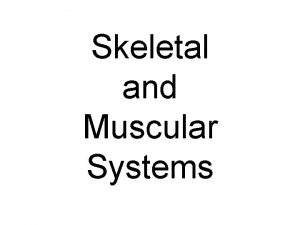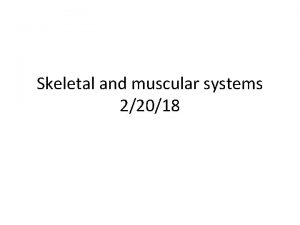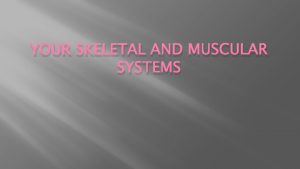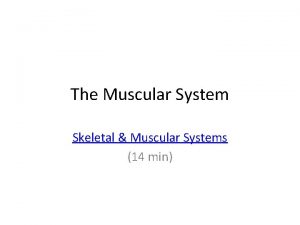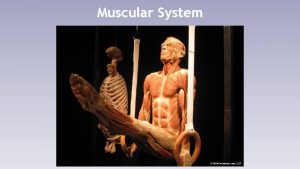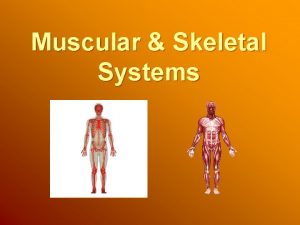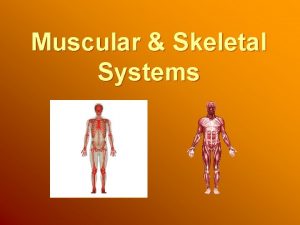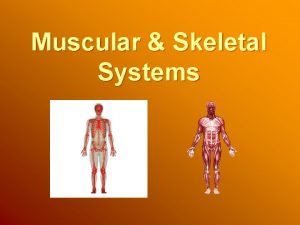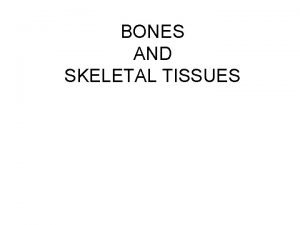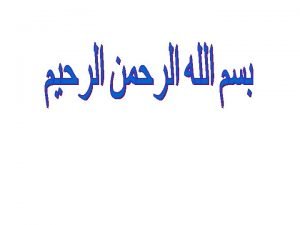Unit 1 Lesson 2 The Skeletal and Muscular























- Slides: 23

Unit 1 Lesson 2 The Skeletal and Muscular Systems Copyright © Houghton Mifflin Harcourt Publishing Company

Unit 1 Lesson 2 The Skeletal and Muscular Systems What’s Inside? What are the main functions of the skeletal system? • A skeleton is a system of bones which are alive. • The skeletal system is the organ system that supports and protects the body and allows it to move. • An endoskeleton is a skeleton inside the body. Copyright © Houghton Mifflin Harcourt Publishing Company

Unit 1 Lesson 2 The Skeletal and Muscular Systems What are the main functions of the skeletal system? • The skeletal system stores minerals and produces red blood cells. • Bones, like the ribcage and skull, provide protection for organs like the heart and brain. • Bones provide support for your body and make it possible to stand sit. Copyright © Houghton Mifflin Harcourt Publishing Company

Unit 1 Lesson 2 The Skeletal and Muscular Systems What are the main functions of the skeletal system? • Bones provide a place for muscles to attach. The muscles pull on bone and cause movement. • Marrow is a soft tissue at the center of bones. Red marrow makes red and white blood cells. • The hard outer layer of bone, called compact bone, stores minerals such as calcium. Copyright © Houghton Mifflin Harcourt Publishing Company

Unit 1 Lesson 2 The Skeletal and Muscular Systems No Bones About It! What are the parts of the skeletal system? • The skeletal system is divided into two parts. • The skull, vertebrae, and ribs make up the axial skeleton, which supports and protects the internal organs. • The appendicular skeleton includes the arms, legs, shoulders, and pelvis. Copyright © Houghton Mifflin Harcourt Publishing Company

Unit 1 Lesson 2 The Skeletal and Muscular Systems What are the parts of the skeletal system? • Bones are alive. They have a blood supply and nerves. • A ligament is the tough, flexible strand of connective tissue that holds bones together. • Cartilage is a strong, flexible, and smooth connective tissue found at the end of bones that allows them to move smoothly. Copyright © Houghton Mifflin Harcourt Publishing Company

Unit 1 Lesson 2 The Skeletal and Muscular Systems What are bones made of? • Compact bone is dense and hard, with no visible open spaces. • Spongy bone provides most of the strength and support for the bone. It has many open spaces. • Bones also contain marrow, the soft tissue in the center of bones. • Calcium, the most plentiful mineral in bones, is deposited by bone cells called osteoblasts. Copyright © Houghton Mifflin Harcourt Publishing Company

Unit 1 Lesson 2 The Skeletal and Muscular Systems What are bones made of? • Connective tissue is made mostly of a protein called collagen, which allows bones to be a bit flexible. • Red marrow, at the center of flat bones, makes red and white blood cells. • Yellow marrow, at the center of long bones, stores fat. Copyright © Houghton Mifflin Harcourt Publishing Company

Unit 1 Lesson 2 The Skeletal and Muscular Systems What are bones made of? • What are the functions of each of the parts of bone? v Copyright © Houghton Mifflin Harcourt Publishing Company

Unit 1 Lesson 2 The Skeletal and Muscular Systems How do bones grow? • Babies have cartilage that is later replaced by bone. • Growth plates are locations where long bones lengthen. • Osteocytes are bone cells that move into cartilage and harden it into bone. Copyright © Houghton Mifflin Harcourt Publishing Company

Unit 1 Lesson 2 The Skeletal and Muscular Systems Bone Connections How are bones connected? • A joint is the place where two or more bones connect. • Fixed joints are found in the skull and allow no movement between bones. • Movable joints allow movement of the bones. Copyright © Houghton Mifflin Harcourt Publishing Company

Unit 1 Lesson 2 The Skeletal and Muscular Systems How are bones connected? • Ball and socket joints allow one of the bones to rotate in a large circle. Copyright © Houghton Mifflin Harcourt Publishing Company

Unit 1 Lesson 2 The Skeletal and Muscular Systems How are bones connected? • Gliding joints allow flexibility in the wrist and ankles. Copyright © Houghton Mifflin Harcourt Publishing Company

Unit 1 Lesson 2 The Skeletal and Muscular Systems How are bones connected? • Hinge joints allow bones to move back and forth. Copyright © Houghton Mifflin Harcourt Publishing Company

Unit 1 Lesson 2 The Skeletal and Muscular Systems What are some injuries and disorders of the skeletal system? • Fractures are bones that are broken. • Sprains are injuries to a ligament caused by stretching a joint too far. • Osteoporosis is a disease that causes bone to become thin and weak. • Arthritis is a disease that causes joints to stiffen, swell, and become painful. Sometimes the joint becomes misshapened. Copyright © Houghton Mifflin Harcourt Publishing Company

Unit 1 Lesson 2 The Skeletal and Muscular Systems Keep Moving! What are the main functions of the muscular system? • The muscular system is mostly made of the muscles that allow a body to move and be flexible. • Muscle is the tissue that contracts and relaxes, making movement possible. Copyright © Houghton Mifflin Harcourt Publishing Company

Unit 1 Lesson 2 The Skeletal and Muscular Systems What are three types of muscles? • The three types of muscle are skeletal, smooth, and cardiac. • Voluntary muscle is skeletal muscle that you are able to control. • Involuntary muscle is the smooth and cardiac muscle you cannot control. Copyright © Houghton Mifflin Harcourt Publishing Company

Unit 1 Lesson 2 The Skeletal and Muscular Systems What are three types of muscles? • Smooth muscle is found in internal organs and blood vessels. • Cardiac muscle is the tissue that makes up the heart. • Skeletal muscle is attached to bones by tough strands of tissue called tendons. Copyright © Houghton Mifflin Harcourt Publishing Company

Unit 1 Lesson 2 The Skeletal and Muscular Systems What are three types of muscles? • Most skeletal muscles work in pairs around a joint. • The flexor bends the joint. • The extensor straightens the joint. • As one muscle contracts, the other muscle relaxes. Copyright © Houghton Mifflin Harcourt Publishing Company

Unit 1 Lesson 2 The Skeletal and Muscular Systems What are three types of muscles? • Point out the location of a flexor muscle and an extensor muscle. Copyright © Houghton Mifflin Harcourt Publishing Company

Unit 1 Lesson 2 The Skeletal and Muscular Systems Move It or Lose It! What are some injuries and disorders of the muscular system? • A strain is a muscle injury in which a muscle is overstretched or torn. • Muscular dystrophy causes skeletal muscle to become weaker over time. • Tendinitis occurs when tendons become inflamed or torn. Copyright © Houghton Mifflin Harcourt Publishing Company

Unit 1 Lesson 2 The Skeletal and Muscular Systems What are some benefits of exercise? • Exercise is any activity that helps improve physical fitness and health. • Exercise can increase strength, endurance, and flexibility. It can also improve heart and lung function and reduce stress. • People should get 30 to 60 minutes of exercise a day. Copyright © Houghton Mifflin Harcourt Publishing Company

Unit 1 Lesson 2 The Skeletal and Muscular Systems What are some benefits of exercise? • Resistance exercises are anaerobic exercises. Anaerobic exercises do not require oxygen for contraction, and involve short bursts of intense effort. • Endurance exercises are aerobic exercises. Aerobic exercises require oxygen for contraction, and involve extended periods of movement. • Flexibility is improved by stretching muscles. Copyright © Houghton Mifflin Harcourt Publishing Company
 Chapter 36 skeletal muscular and integumentary systems
Chapter 36 skeletal muscular and integumentary systems Chapter 14 the skeletal muscular and nervous systems
Chapter 14 the skeletal muscular and nervous systems Skeletal and muscular system
Skeletal and muscular system Skeletal and muscular system
Skeletal and muscular system Plyometrics disadvantages
Plyometrics disadvantages Lesson outline lesson 2 the muscular system answer key
Lesson outline lesson 2 the muscular system answer key Hyp opp adj triangle
Hyp opp adj triangle Lesson 5.1 the organization of a skeletal muscle
Lesson 5.1 the organization of a skeletal muscle Lesson 5.1 the organization of a skeletal muscle
Lesson 5.1 the organization of a skeletal muscle Unit 6:5 muscular system
Unit 6:5 muscular system Unit 6 review questions
Unit 6 review questions A long and narrow muscular tube that relaxes and contracts
A long and narrow muscular tube that relaxes and contracts Hát kết hợp bộ gõ cơ thể
Hát kết hợp bộ gõ cơ thể Ng-html
Ng-html Bổ thể
Bổ thể Tỉ lệ cơ thể trẻ em
Tỉ lệ cơ thể trẻ em Voi kéo gỗ như thế nào
Voi kéo gỗ như thế nào Tư thế worms-breton
Tư thế worms-breton Alleluia hat len nguoi oi
Alleluia hat len nguoi oi Kể tên các môn thể thao
Kể tên các môn thể thao Thế nào là hệ số cao nhất
Thế nào là hệ số cao nhất Các châu lục và đại dương trên thế giới
Các châu lục và đại dương trên thế giới Công của trọng lực
Công của trọng lực Trời xanh đây là của chúng ta thể thơ
Trời xanh đây là của chúng ta thể thơ


